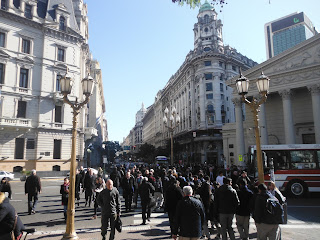Continuing my Top 10 Lists is the ten most incredible things I experienced in the past two years. Nuffield trips are centred around research, meetings and learning opportunities. However, mixing in a little fun and filling half a day until the next meeting or coming into a city a day earlier allows for some sight seeing and rest. I had a number of "can't believe I am here" moments while travelling, narrowing down this list was a real challenge.
Top 10 Travel Moments:
10. Random Roadside Attractions, Australia - The Big Guitar, Big Mower, Big Macadamia Nut, Big Pineapple, Big Ayrshire all things I came across while driving down the highway in Australia.
 |
| Henry VII's clock, Hampton Court |
8. In and Around London, United Kingdom - Hampton Court, Jane Austen House, Walking along the Thames River - London and the surrounding area was incredible. The history and the natural beauty of the area was something to see and I want to go back when I have more time.
 7. Hong Kong Disneyland - After almost five weeks on the road I and a few days in Hong Kong, I needed a break. Meetings fell through and I ended up with some time on my hands, what a better way to kill a day then at Disneyland.
7. Hong Kong Disneyland - After almost five weeks on the road I and a few days in Hong Kong, I needed a break. Meetings fell through and I ended up with some time on my hands, what a better way to kill a day then at Disneyland.
6. Skiing in Santiago, Chile - Conditions may not have been ideal but two days of skiing in the Andes was quite the experience. The Andes are extensive and rugged and stunning.
5. Uruguay - For those of you who I have talked to since I returned home in August, you know how much I loved the Uruguay section of my recent trip. The city of Montevideo was incredible and the countryside even more so. This is a country I will return to soon.
4. Hiking along the Great Wall of China - On a somewhat clear day which made it even better, then coming down through a small scale traditional farm in the Chinese countryside, it is a day I will not forget.

3. Sunrise at Uluru, Northern Territory, Australia - I remember this day well, after a bad night sleep in a hostel the last thing I wanted to do that morning was get up before the sun was up and drive over to the viewing area. But I willed myself to get out of bed that morning and I was glad I did. The series of photos shows the entire sunrise over Uluru on a beautiful fall morning.
2. Igauzu Falls, Brazil - The pictures of these waterfalls do not do them justice. It is hard to even take them all in let alone describe. Check out the video.

 1. Eiffel Tower, Paris, France - Paris in the fall in the rain. It only gets slighty more cliche than that (it could have been the spring) but the sun came out when I arrived at the tower allowing me to take the stairs which was an experience in itself. An iconic moment at an iconic location. With one day in Paris it was the only place to go.
1. Eiffel Tower, Paris, France - Paris in the fall in the rain. It only gets slighty more cliche than that (it could have been the spring) but the sun came out when I arrived at the tower allowing me to take the stairs which was an experience in itself. An iconic moment at an iconic location. With one day in Paris it was the only place to go. 











































